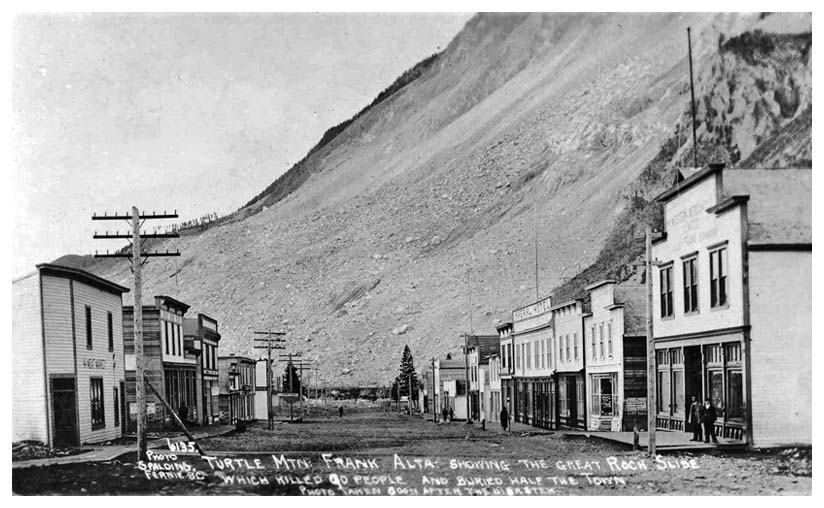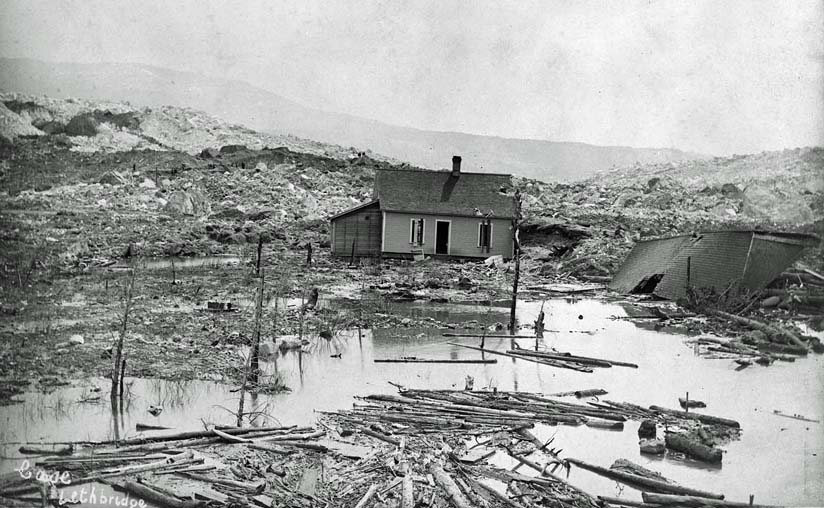
In the spring of 1901, Sam Gebo and Henry Frank opened the region's first coal mine at the base of Turtle Mountain and a small community, named in Frank's honour, grew up around the mine. The rich coal seams allowed for the rapid extraction of coal and the mine appeared profitable. By 1903 production exceeded 1,000 tons per day and a tunnel had been driven over 1.7 km (5,500 feet) into the mountain. The dark form of the tunnel entrance can still be seen today at the edge of the Slide on the opposite side of the Crowsnest River.
At 04:10 on 29 Apr 1903 the top of Turtle Mountain broke loose and came crashing down on the valley below. The entrance and many of the surface buildings of the Frank Mine were obliterated as were a small number of homes and businesses on the eastern edge of the town. Fortunately, most of the town of Frank was spared from the destruction that buried three square kilometres of the valley bottom in limestone boulders. An estimated 90 people were killed in the rock slide.

Sid Choquette
At the moment the rocks came crashing down Turtle Mountain, engineer Ben Murgatroyd was driving his steam engine from the mine yard. Brakemen Sid Choquette and Bill Lowes clung to the side of the engine as it rumbled to safety just ahead of the rocks. In the hectic moments following the slide, the railway men remembered that a CPR passenger train was travelling west from Lethbridge. In the darkness the train would come upon the unexpected rock slide and crash into a wall of rocks. Choquette and Lowes, with lanterns in hand, headed out across the two kilometres of unstable rocks in a race to stop the train. Lowes was soon unable to continue but urged Choquette to carry on. Choquette made his way through the rubble and was able to flag down the passenger train before it reached the rocks. For his heroic efforts, the Canadian Pacific Railway honoured Sid Choquette with a letter of commendation, a job for life if he so wished, and a cash reward of $25, a handsome sum for the times.
Big Charlie
There were also a number of mine horses working the night shift at the time of the Frank Slide. Most of them were near the entrance and were killed, but one horse deep in the mine was unhurt. Big Charlie's survival was unknown to the seventeen trapped miners who made good their escape. It would be thirty-one days before the first men re-entered the mine to assess the damage. For that entire month, Big Charlie stayed alive in the pitch-black of the mine by drinking seepage water and chewing on mine timbers and his harness. The miners were elated when they eventually reached Big Charlie and found him alive. Oats and brandy were brought down into the mine for the starving horse. Unfortunately the food was too rich for his stomach and Big Charlie, the last casualty of the slide, passed away.
Trapped Miners
Twenty men were working the night shift at the Frank Mine when the slide occurred. Three of the workers were outside the mine entrance at the weigh scale and were buried by the rocks. Seventeen others were safe inside the mine, but the main and lower entrances were blocked by the slide. The trapped miners made attempts to escape through air shafts but found them all impassible, and quickly recognized that they had a limited air supply. Foreman Joe Chapman suggested a plan for the men to mine their way out through a coal seam. Working alone or in pairs in the small shaft, the miners escaped to the surface thirteen hours after the slide had entombed them, unaware of the destruction on the surface. The miners popped out of the rocks a mere fifty metres above the mine's destroyed entrance where a rescue crew was busy working. Amid the utter destruction of the slide, Frank residents had not expected the miners to survive and were overjoyed to see the trapped men emerge from their would-be crypt.
Mine Reopens
Within three months of the Frank Slide, the original entrance to the mine was cleared, tracks were laid, and coal production started again. After the death of Henry Frank in 1908, the mine was operated by the Canadian Coal Consolidated Company until 1912. The Frank Mine was reopened in 1914 by the Franco-Canadian Coal Company, but suspended operations in 1917 after a major fire.
Author unknown.
(because there was no image with original article)
(usually because it's been seen before)
provisions in Section 29 of the Canadian
Copyright Modernization Act.

